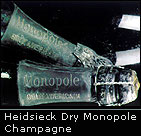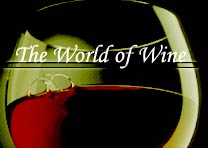Heidsieck & Co Monopole Champagne
 A
message in a bottle, lost at sea.
A
message in a bottle, lost at sea.
During World War One, November 3, 1916, off the coast of Finland, a German Submarine sunk the Swedish ketch: Jonkoping. The cargo sank while on its way to St Petersburg, with on board special shipment of 10,000 gallons of Cognac, 17 barrels of Burgundy Wine, 3000 bottles of Heidsieck & Co Monopole 1907 "Gout Americain" dedicated to the Russian Imperial Army.
Unfortunately, the Cognac and the barrels of Burgundy wine did not survive the 82 years spent in the sea, but 2500 bottles of Heidsieck & Co Monopole champagne were extraordinarily preserved.
The goods (Champagne, Cognac and Burgundy) were at first conveyed from Le Havre to Galve, in Sweden then transhipped on the Jonkoping. The freight was aimed to be delivered in Finland, in Rauma, then to be transported by rail to St Petersburg (These wines and alcohol being for the headquarters of the Russian Imperial Army).
 During
the Sweden/Finland crossing, early on the morning of
November the 3rd, 1916, the Jonkoping was sunk by a
German U-boat.
During
the Sweden/Finland crossing, early on the morning of
November the 3rd, 1916, the Jonkoping was sunk by a
German U-boat.
In the summer of 1997, the wreck was found by a Swedish search team and lifted to the surface in July 1998.
The Burgundy wine did not live up to 82 years of immersion, but the 21 barrels of Cognac could be salvaged and the bottles of Heidsieck & Co Monopole "Gout Americain" 1907 fortunately survived, remaining in excellent condition and now revealing a fabulous taste.
Purveyors of Champagne, by appointment to his Majesty
In the beginning of the century, Heidsieck & Co Monopole was a top leading (just behind Moet et Chandon), appointed by the Tsar Nicolas II, by the Emperor of Germany, the Emperor of Austria-Hungary and was present world-wide. In 1911, the King of England granted the prestigious Royal Warrant to the House, which becomes "Purveyors of Champagne by appointment to his Majesty".
As regards to Russia, the brand was famous and recognised and in 1900/1910, more than 250,000 bottles a year were shipped to Russia.
Why are the bottles so well preserved?
 Firstly,
the bottles were shipped in strong wooden cases, preventing
them from breaking whilst sinking into the deep sea.
Secondly, they were stored for 82 years in the complete
darkness, 197 feet (64 metres) below sea level at a
constant temperature of 35 degrees F (+3 to +4 degrees
C).
Firstly,
the bottles were shipped in strong wooden cases, preventing
them from breaking whilst sinking into the deep sea.
Secondly, they were stored for 82 years in the complete
darkness, 197 feet (64 metres) below sea level at a
constant temperature of 35 degrees F (+3 to +4 degrees
C).
The water pressure actually worked perfectly to help the cork stay in place and keep the effervescence inside the bottles. The are no worms or parasites in the Baltic sea to destroy the wooden cases or the cork, which were perfectly preserved. Out of the water, the bottles were immediately sealed to avoid oxidation. Storage has been handled very carefully.
Analysis result and tasting notes of a sample of Jonkoping.
 A
high dosage wine (42.55 grams of sugar) No malolactic
fermentation No lack of alcohol: 12.35° The result
of the analysis (PH of 2.93, total acidity 5.35g H2SO4/litre…)
reveals this wine to be very well balanced The colour
is dark, deep golden yellow. Lively sparkling. Persisting
foam and small bubbles. The tasting confirms that this
Champagne has no disturbing oxidation, no maderization
and a good taste. Strong, aromatic richness with honey
dominance, crystallised fruits and currants. Long and
exceptional finish and aftertaste.
A
high dosage wine (42.55 grams of sugar) No malolactic
fermentation No lack of alcohol: 12.35° The result
of the analysis (PH of 2.93, total acidity 5.35g H2SO4/litre…)
reveals this wine to be very well balanced The colour
is dark, deep golden yellow. Lively sparkling. Persisting
foam and small bubbles. The tasting confirms that this
Champagne has no disturbing oxidation, no maderization
and a good taste. Strong, aromatic richness with honey
dominance, crystallised fruits and currants. Long and
exceptional finish and aftertaste.
History of a great Champagne House
Founded more than two centuries ago, Heidsieck & Co Monopole in Reims is one of the oldest and most prestigious houses in Champagne history.
 In
1785, Florens-Louis Heidsieck, a young German from Westphalia,
establishes the first Champagne house with the Heidsieck
name. As he has no children, his nephews take over upon
his death in 1828. the three nephews go their separate
ways and Heidsieck & Co is taken over by the eldest,
Henri-Louis Heidsieck. In 1860 they create "Monopole"
as a registered trademark of the company Heidsieck &
Co. In 1923 it is integrated into the name, becoming:
"Champagne Heidsieck & Co Monopole, founded
in 1785".
In
1785, Florens-Louis Heidsieck, a young German from Westphalia,
establishes the first Champagne house with the Heidsieck
name. As he has no children, his nephews take over upon
his death in 1828. the three nephews go their separate
ways and Heidsieck & Co is taken over by the eldest,
Henri-Louis Heidsieck. In 1860 they create "Monopole"
as a registered trademark of the company Heidsieck &
Co. In 1923 it is integrated into the name, becoming:
"Champagne Heidsieck & Co Monopole, founded
in 1785".
In 1911, the King of England grants the prestigious Royal Warrant to the house, which becomes "Purveyors of Champagne by appointment to his Majesty" Heidsieck & Co Monopole is a member of the "Syndicat des Grandes Marques" and the Champagne academy in England, which has represented this and 15 other major Champagne houses since its creation in 1956.
 In
1985, Heidsieck & Co Monopole celebrates the bicentennial
of a long and illustrious Champagne history that continues
to develop throughout the world.
In
1985, Heidsieck & Co Monopole celebrates the bicentennial
of a long and illustrious Champagne history that continues
to develop throughout the world.
In November 1996, Heidsieck & Co Monopole has been acquired by Vranken Champagne Group. A leading group within the industry (in the top five), created twenty years ago and managed by Paul-Francois Vranken, the group is entirely devoted to Champagne, with a complete portfolio of brands, with Hiedsieck & Co Monopole as its flagship international ambassador. The Vranken Group has full control of grape supply, pressing and wine making, through 400 acres of their own vineyards and over 2,000 acres of direct controlled vineyards throughout the Champagne region.
If you are interested in a bottle of Heidsieck & Co Monopole champagne, contact us.





